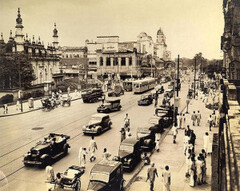In Praise of Kolkata
Translator's Introduction
Much has been written in recent years about the life of Gendün Chöpel (dGe ‘dun chos ‘phel, 1903–1951) and his travels through India and Sri Lanka in the 1930s and 40s. The very latest offering, Grains of Gold: Tales of a Cosmopolitan Traveler (trans. Thupten Jinpa and Donald S. Lopez Jr, Chicago and London: University of Chicago Press, 2014), is in many ways the most fascinating.
In Praise of the Great Indian City of Kolkata
by Jamyang Khyentse Chökyi Lodrö
Oṃ svasti!
Vast grove delighting Mahādeva’s mighty consort,
Realm of the glorious Lord of the World,
Eternal wonder transported to this land.
Place where all eighteen trades are plied,[1]
And people from every race in Jambudvīpa
Gather spontaneously, like bees to honey.
Such varied and splendid riches abound,
As if Vaiśravaṇa's very troves of treasure
Had offered up the world's wealth, with nothing wanting.
All kinds of people—beautiful, ugly and in-between—
As numerous as specks of dust,
Come to vie with one another;
Not even Indra's thousand eyes could behold them all!
So many contraptions and machines
Fill the ears with a thousand clatterings,
Make earth tremble and air rumble like thunder,
And the talk in kumbhāṇḍa, gandharva and other tongues –
It's a wonder we aren't all deaf!
Boats, sparkling like stars, sail back and forth
As if the Ganga herself—finely laid across Jambudvīpa,
Had dragged them there, as precious stones.
Plants and trees laden with fruit,
And, better still, tangled groves
Of luscious greenery—a sight to behold!
Mansions too, magnificently balconied,
With silver and gold, many doorways
And skylights to gladden any heart.
Electric lights, like radiant gemstones,
White, red, yellow, blue and green,
Make it hard to tell night from day—
Fools might even wonder which is which!
Food, drink, clothing, adornments, garlands,
And ointments—everything you might need—
All are here, readily and instantly available,
As if conjured by a bodhisattva’s prayer.
That such a heavenly scene as this
Should exist here in this human realm
Seems hardly possible, but I've seen it—
Certain proof that it's no phantom!
As for the pearl-like relics of the tathāgata,[2]
Supreme amongst all precious vajra substances,
Everything else in existence and peace, all gathered up,
Would not approach even a fraction of their worth.
With offerings from gods and men that defy the imagination
All laid out before them, to look and see is to be liberated!
These sacred objects gracing the world with their beauty
Are more than worthy of veneration, both earthly and divine.
These words of wonder were composed by Lodrö Gyatso
In the twelfth (rgyal) month,
On the tenth day of the waxing moon,
When the vīras and ḍākinīs gather.
May they be virtuous!
| Translated by Adam Pearcey and edited by Janine Schulz, 2014. With many heartfelt thanks to Ringu Tulku Rinpoche who kindly answered questions about the text. Originally published on adamspearcey.com.
Bibliography
Tibetan Editions
'jam dbyangs chos kyi blo gros. "rgya gar ka la ka ta'i grong khyer chen po la bstod pa/" in gsung 'bum/_'jam dbyangs chos kyi blo gros/ (dbu med/). BDRC W21813. 8 vols. Gangtok: Dzongsar Khyentse Labrang, 1981–1985. Vol. 1: 291–293
_____ . "rgya gar ka la ka ta'i grong khyer chen po la bstod pa/" in ’jam dbyangs chos kyi blo gros kyi gsung ’bum. 12 vols. Bir: Khyentse Labrang, 2012. W1KG12986 Vol. 10: 371–372
Secondary Sources
Jamgön Kongtrul Lodrö Tayé, Buddhist Ethics. Ithaca, NY: Snow Lion Publications, 1998
Version: 1.5-20250417
-
The traditional definition of a major town (grong khyer) is a place where the eighteen trades or crafts are present. For a list of the eighteen see Jamgön Kongtrul Lodrö Tayé, Buddhist Ethics: p. 422, n. 70. ↩
-
As noted in the translator's introduction, this is presumably a reference to the contents from the stūpa at Birdpur (now Piprahwa) in Uttar Pradesh, discovered in 1898 and then placed in Kolkata’s Indian Museum. ↩
